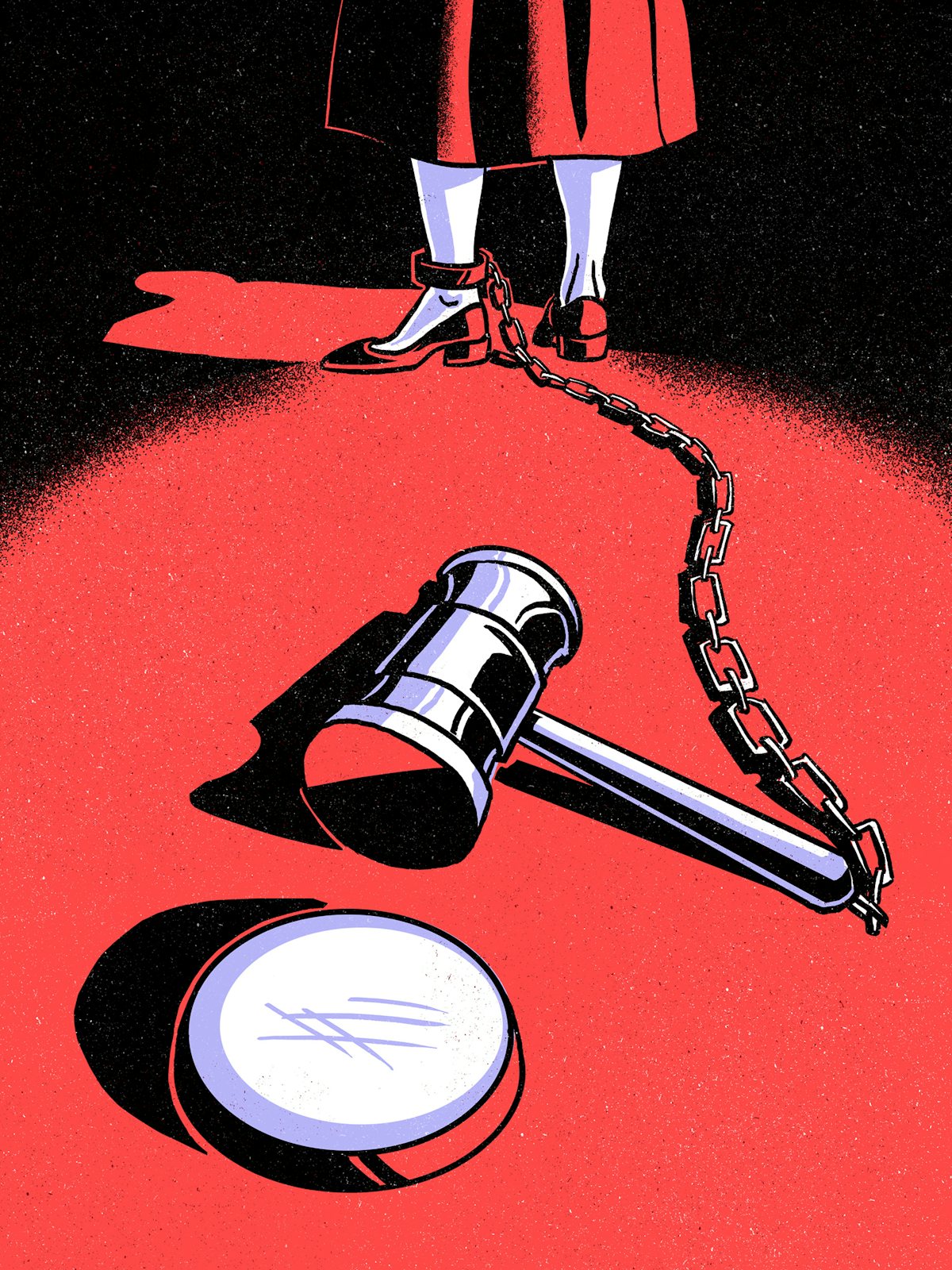This summer, Roe v. Wade will fall. It should be dangerous to write such an emphatic prediction about a decision the Supreme Court won’t issue for at least a month, if not longer; at this point, we should still be allowed the solace, however slight, of entertaining more than one plausible future. But on an otherwise quiet evening in early May, in an unprecedented move, Politico published a leaked draft opinion in Dobbs v. Jackson Women’s Health Organization, the Mississippi case that has been poised to determine Roe’s fate. Written by Samuel Alito, the sweeping opinion announced in no uncertain terms that the much-feared end of Roe was upon us. Roe’s “weak” reasoning had inflicted “damaging consequences,” Alito wrote with discernible glee; in point of fact, it “was egregiously wrong from the start.” To be sure, draft opinions frequently get revised. But unless Chief Justice John Roberts can soon persuade a colleague to change his or her mind, the Supreme Court’s conservative majority will, in late June or early July, upend a constitutional protection we’ve relied on for nearly 50 years, and unleash a torrent of laws in red states that will further circumscribe or even deny the right to end a pregnancy.
Underneath the flurry of news stories following the leak; in between people’s disbelieving conversations; behind the determination of the organizers and doctors who are working as hard as ever, harder, to preserve abortion access, ran a kind of silent river: the memories of the abortions we had or didn’t have. An abortion has a way of persisting in the mind, or maybe the body. You faced a divergence—this choice, or that one. There isn’t a disquiet sharper than the dread of consequence; there are few finalities more final than life or not life. An unhad abortion is also a terminal path. The abortions that rested lightly, the abortions that were cheap and easy to find, the abortions where the choice was clear and the relief undiluted—they persist, too. What could have gone one way went another.
Surely the justices on the highest court in the country should have encountered at one moment or another in their storied careers the sublimity, the terror, of this decision. But the conservative majority, whose opinions will in all likelihood prevail in Dobbs, have shown spectacularly few misgivings about what their judgments in it will do to women, and almost no understanding of what it means to need or want an abortion—even though, statistically speaking, such ignorance seems difficult to maintain. (According to a 2017 analysis, nearly one in four women will have an abortion before age 45.) During December’s oral arguments in Dobbs, Amy Coney Barrett, a mother of seven children, implied that pregnant women concerned about the burden of parenthood could leave their babies at a fire station. If arguments in support of Roe have emphasized the hindrance to equal opportunity or the tribulation of “forced motherhood,” Barrett said, wouldn’t safe haven laws—which protect the antiquated practice of giving up a child by depositing it at certain designated locations—simply “take care of that problem”?
If it isn’t surprising that the five conservative justices on the highest court in the country have little appreciation for the material or emotional difficulties of pregnancy or parenthood, it’s noteworthy that they didn’t care to hide it, that there wasn’t more effort put to disguising their lack of regard—particularly if they are concerned, as at least some of them claim to be, with the court’s reputation, which has sharply declined. (In 2021, just 49 percent of Americans approved of the job it’s doing.) The justices’ responses in oral arguments came across not just as “things you would say if you’re going to overrule Roe,” the legal historian Mary Ziegler told me, “but things you would say if you had no idea this would negatively affect anyone.” In Alito’s draft opinion, the justice shrugged off the profound social, legal, and financial costs of forcing people to carry unwanted pregnancies to term, said Rachel Rebouché, a scholar of reproductive health law. Yet this group of five is as familiar as anyone with the arguments in support of abortion as a foundational right. Their ignorance is mostly feigned. Their disregard is real.
It’s not news that the balance of the court has changed dramatically in recent years. In 2016, Senate Republicans famously refused to confirm Barack Obama’s final nominee, Merrick Garland, holding the position open until after the election. Donald Trump then enjoyed the rare good fortune of appointing three justices: Neil Gorsuch, who succeeded conservative Antonin Scalia; Brett Kavanaugh, who succeeded swing voter Anthony Kennedy; and Amy Coney Barrett, who succeeded liberal Ruth Bader Ginsburg. The remaining three liberals—Sonia Sotomayor, Elena Kagan, and Stephen Breyer (who will be replaced at the end of the court’s current term, in late June or early July, by President Joe Biden’s nominee, Ketanji Brown Jackson)—are sometimes joined in their opinions by Chief Justice John Roberts, who is plausibly described as a centrist on a court dominated by ultraconservatives. If Donald Trump’s three appointees thrust the court definitively to the right, this lopsided configuration is not just the result of a terrible president and some accidents of timing; it’s the culmination of the Republican Party’s long, concerted project to fill the court with judges who would be sympathetic to destroying Roe. Going as far back as Ronald Reagan, Republican judicial nominees to both the lower courts and the Supreme Court were appointed “in large part based on their opposition” to abortion, said Nan Aron, the founder and former president of Alliance for Justice.
In considering Dobbs, the court opened two doors: It would either strike down Roe, as Alito’s draft opinion has now announced it will do, or weaken it to the point of nullity. Mississippi’s Gestational Age Act, the law in question, bans abortion after 15 weeks (except in instances of medical emergency or fetal abnormality). As such, it is patently unconstitutional, as both the lower courts that reviewed it found. The mere fact that the justices agreed to take the case in the first place signaled an interest in, if not overturning Roe, then certainly eviscerating it. There was simply no reason to hear Dobbs, Rebouché said, unless the court wanted to assert something dramatic about precedent.
Roe set forth the straightforward rule that a woman has a constitutional right to an abortion without state interference before fetal viability, usually judged to be around 24 weeks. The 7–2 majority opinion introduced the viability line, reasoning that the state’s interest in protecting the fetus won out only after it was “capable of independent existence.” Though Alito is not the only person to criticize the opinion for being weakly argued, the standard it offered was quite strong: Because it classified the right to an abortion before viability as fundamental, it was subject to “strict scrutiny,” the highest level of judicial review. In abortions before viability, in short, states were categorically not allowed to interfere.
A second landmark case, however, established a standard that was significantly less protective. Planned Parenthood v. Casey took on a Pennsylvania law that required, among other things, that a married woman who wanted an abortion get permission from her spouse. The 1992 opinion is often described as affirming Roe, and in the narrow sense of upholding a constitutional right to abortion, it did. But it also hollowed it out. After Casey, states were allowed to regulate pre-viability abortions however they wanted, so long as the regulations did not constitute an “undue burden.” It was now perfectly permissible, in other words, to put obstacles in the path of an abortion seeker, if those obstacles passed this nebulous test. Casey allowed states to introduce virtually whatever regulation they wished, and it opened the door to the flood of restrictions with which we’ve become, over the past 30 years, all too familiar.
The Politico leak makes clear that there is little chance of any outcome but Roe’s being overruled outright. Alito’s draft opinion may see its rough edges sanded down before a decision is officially released, but the fundamental principle it sets forth is likely to remain: that the Constitution and specifically the Fourteenth Amendment do not include any right to abortion before viability—or any right that implies a right to abortion—and states should be free to regulate or outlaw it however they like. As Ziegler, the legal historian, pointed out, if the court’s ultimate aim is to overturn Roe, it makes a great deal more sense to do it now than in a later decision, when it would have to disregard not only Roe and Casey but the precedent set by its own ruling in Dobbs.
It may remain at least dimly possible, however, that the draft opinion won’t represent the court’s final verdict. There is no way to uphold the Mississippi law without decimating Roe. But by leaving its essential holding untouched while abolishing the viability standard, the court could effectively undo the ruling without literally overturning it. One way of doing that, said Linda C. McClain, a law professor at Boston University, would be an opinion that claims “they’re simply clarifying that the core part of Roe is that women must have a fair opportunity of choice, and viability isn’t critical.” In doing so, the court could offer a kind of “minimalist” opinion, as Ziegler put it, arguing that it is acceptable to ban abortion before that point and declining to offer an alternative standard; it would be left to a later case to articulate some new measure for determining whether a law is unconstitutional. Or the opinion could propose a new test of measuring which regulations or bans are appropriate—say, for example, “rationality.” A rational basis test would require states to have a credible reason for imposing a law. But those reasons could be anything, and “credible” would be in the eye of the beholder. Really, all a rationality standard would ask is that states have a reason. For better or worse, such an outcome would, as McClain said, “keep the court in the abortion business.”
Even if Roberts were by some feat of persuasion to pull the court back from the hard line of the Alito opinion—if he could make the conservative justices stop short of explicitly reversing Roe in favor of arguing merely that viability isn’t an appropriate threshold—states would still be granted an enormous amount of leeway: They could ban at “seven weeks, three weeks, one week,” Rebouché said; if they just produce a reason, they could ban abortion altogether.
In sum: Roe is dead, or Roe is dead.
As a bloc, the conservative justices have not taken great pains to conceal their distaste for the 1973 ruling. Justice Clarence Thomas, the staunchest pro-life vote, has repeatedly questioned the “entire body of law in which abortion is rooted,” Ziegler said. During oral arguments, he pressed Elizabeth Prelogar, the solicitor general, to explain how the Constitution protects abortion. “Would you specifically tell me,” he requested in stagy confusion, “what the right is? Is it specifically abortion? Is it liberty? Is it autonomy? Is it privacy?” It is the right to liberty, Prelogar answered, which entails a right to bodily autonomy, and the right of a woman “to be able to control, without the state forcing her to continue a pregnancy, whether to carry that baby to term.” Thomas’s bewilderment went undiminished: “What specifically is the right here that we’re talking about?”
Alito, while not as outspoken as Thomas, has generally seemed to agree with him, and it’s no great surprise that Thomas asked him to write the draft opinion in Dobbs. (When the chief justice doesn’t join the majority opinion, it’s the responsibility of the majority’s most senior member—in this case, Thomas—to assign it.) As Rebouché noted, Alito has long held that Roe “was wrong on the day it was decided and it’s wrong now.” Indeed, much of his draft attempts to justify why this precedent merits undoing. In oral arguments, he had disputed viability as a “principled” line. “If a woman wants to be free of the burdens of pregnancy,” he argued, “that interest does not disappear the moment the viability line is crossed.” And in the draft decision, he returned to this central claim: Roe was never clear about why the line made sense, and Casey, in upholding Roe, also failed to explain it. Together, he insisted, the cases created an “unworkable” standard, inventing a test that lent itself to vastly different interpretations and was impossible to apply with any consistency.
When it comes to their views on abortion, we know far more about Thomas and Alito than Barrett, Kavanaugh, and Gorsuch; the shortness of the latter three’s tenures means there’s less evidence to go on. But they endorsed Alito’s draft, and it’s hard to see their opinions differing from his by any meaningful margin. During oral arguments, Kavanaugh, in his bloodless way, seemed obsessed with the idea that on the question of abortion the Constitution is “neutral,” and the court should in turn be “scrupulously neutral” itself rather than “continuing to pick sides” on a “contentious social issue.” Gorsuch showed his hand in June Medical Services v. Russo, the most recent abortion case the court took up, and the only opportunity we’ve had to see Gorsuch and Kavanaugh write opinions on the subject (at the time, Barrett had not yet been appointed). The two new conservatives joined Thomas and Alito in the minority opinion—Roberts voted with the liberals—arguing to uphold a Louisiana state law that required abortion doctors to secure hospital admitting privileges. In his dissent, Gorsuch rehearsed the standard anti-abortion script before warning, in dire tones, that the decision was a sign that the court had lost its way.
John Roberts’s vote may be one of the last mysteries in a decision that, after the Politico leak, will doubtless furnish few surprises. Roberts did not endorse Alito’s draft opinion, and he’s occasionally departed from the conservatives. He cares about the court’s reputation. After all, as the legal journalist Linda Greenhouse pointed out in a New Yorker interview, “He’s the one whose name is on the door.” But while Roberts joined the liberals on June Medical, he did not sign with the majority. His vote, he said, was purely about respect for precedent; he disagreed with the ruling in the prior case. Like Alito, he has repeatedly questioned viability as a proper boundary. If the issue is about choice, he said in oral arguments in Dobbs, surely there is a point at which women should have had “the fair choice”: “Why is 15 weeks not enough time?” Even so, it seems likely that, despite Roberts’s lack of affection for Roe, he will vote with the liberal justices, to preserve his personal reputation as someone devoted to stare decisis and to the ideal of a court not in thrall to politics. Indeed, in light of the leak, he may be scrambling to see if he can rally a majority to support a less radical decision. It’s easy to see the appeal, for him, of the middle road: letting Roe stand but undoing the viability standard. Such a ruling could at once uphold the Mississippi law, gut Roe, and tamp down a political firestorm in an election year. That said, he has little chance of swaying the conservative justices. “It’s very clear,” said the constitutional scholar Simon Lazarus, “that he doesn’t have control.”
And in a way, the worse outcome may offer the better hope, at least politically; a half measure might confuse people into complacency.
I first got pregnant when I was 20 years old. I was in college; I was in love. I took the test in the bathroom of the house I shared with two other women. From the window, you could see a row of green bamboo advancing into the backyard’s small oval of paving stones. My course of action seemed indisputable. I made an appointment at a small clinic. For seven days, between the moment I learned I was pregnant and the moment I was no longer pregnant, I felt I had company: sweet, mute, close to tangible. I remember standing next to the tomato plants in our half-hearted garden and enjoying the sensation, painfully. Then it was done. I started failing a class—who fails an art class?—so I sought out the counsel of the graduate teaching fellow, who told me I could complete the final project, a box we were to trick out and film as if it were a life-size movie set, later. I made a white cube with nothing inside. I never filmed it. For years, I counted the age the child would be. Nothing I did with my life seemed to justify not having had that baby until I had a baby, and then, because I wanted this child, wanted him exactly as he was, everything that happened had to have gone exactly as it did.
The only reason my ambivalence seems worth mentioning is that I was allowed it. I had my abortion in Oregon, where ending a pregnancy was legal four years before Roe. None of the typical restrictions other states impose—such as mandatory waiting periods or parental involvement for young people—exist there. In 2017, 29 facilities provided abortions in the state. If Roe is overturned, Oregon will be largely unaffected; 2017’s Reproductive Health Equity Act codified legal access, extended health coverage to people regardless of their immigration status, and required private health insurance plans to cover abortions with no out-of-pocket costs. I was the prototypical abortion seeker as she was historically conceived by the mainstream pro-choice movement: childless, white, not poor, reluctant—a young woman weighing her prospects.
The average person who wants an abortion today doesn’t much resemble my younger self. Usually she’s single and lives below the poverty level; a main reason she cites is that she wants to be a better parent to the kids she already has. Although available evidence about racial demographics is incomplete, it suggests that around a third of abortion seekers (compared to 13 percent of women) are Black. Abortion has been out of reach for so many for so long that, by this measure, Roe may as well have fallen decades ago. In 1976, the Hyde Amendment made it impossible to fund the procedure with Medicaid. If poor people, disproportionately people of color, wanted it, they would have to pay for it themselves. (In 2017, an abortion cost an average of $550, according to the Guttmacher Institute; the expense obviously increases if you have to travel.)
But for all the harm the Hyde Amendment and Casey did to Roe, for all the anticipation of Dobbs, the end still comes as a shock. “Intellectually I am unsurprised,” the journalist Rebecca Traister wrote in the aftermath of the Politico leak. “And yet: my teeth have been chattering uncontrollably for an hour.” When the Supreme Court rips away a protection that has worked itself so deeply into the “fabric of women’s existence,” to use Justice Kagan’s words, we will feel it. What will it mean for the anti-abortion brigade at last to have gotten what they want, for the reproductive rights movement to be forced without question into a defensive posture? If there’s a bright side, it may be that the availability of abortion to certain classes of people will no longer obscure its unavailability to others; we’ll have to stop pretending that the right to end a pregnancy was ever equally distributed. And the error of looking to the courts—certainly to this court—to protect it will be plain, as plain as the need to find other fronts on which to fight.
Since the 1990s, the reproductive justice movement has offered a more comprehensive alternative to the mainstream reproductive rights movement’s singular focus on abortion, recognizing the interrelation of maternal poverty, infant mortality, sex ed, universal childcare. It may seem like a stretch to imagine that a more ambitious program could succeed where a narrower program did not. But it’s not a given that narrower or more modest demands are necessarily more successful. In 2000, the feminist scholar bell hooks argued that, while the issue of abortion was relevant to all women, “there were other reproductive issues that were just as vital which needed attention and might have served to galvanize masses.” Nothing now, in any case, will happen without those masses. Sometimes only unambiguously bad news awakens ambition. Abortion should be cheap, legal, and accessible for everyone. But it’s not all we need, or all we want.






